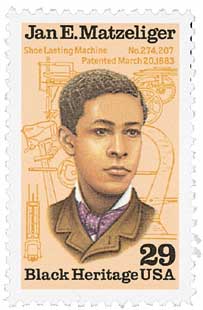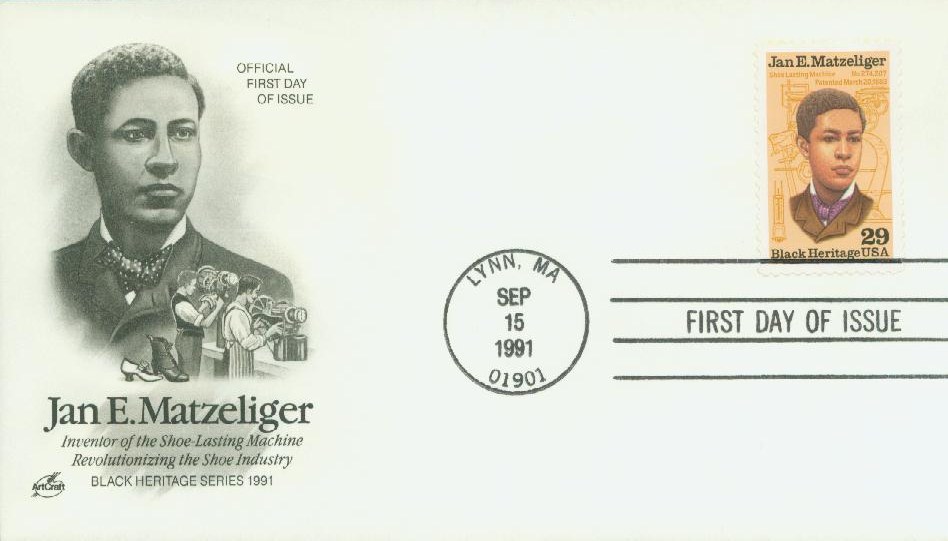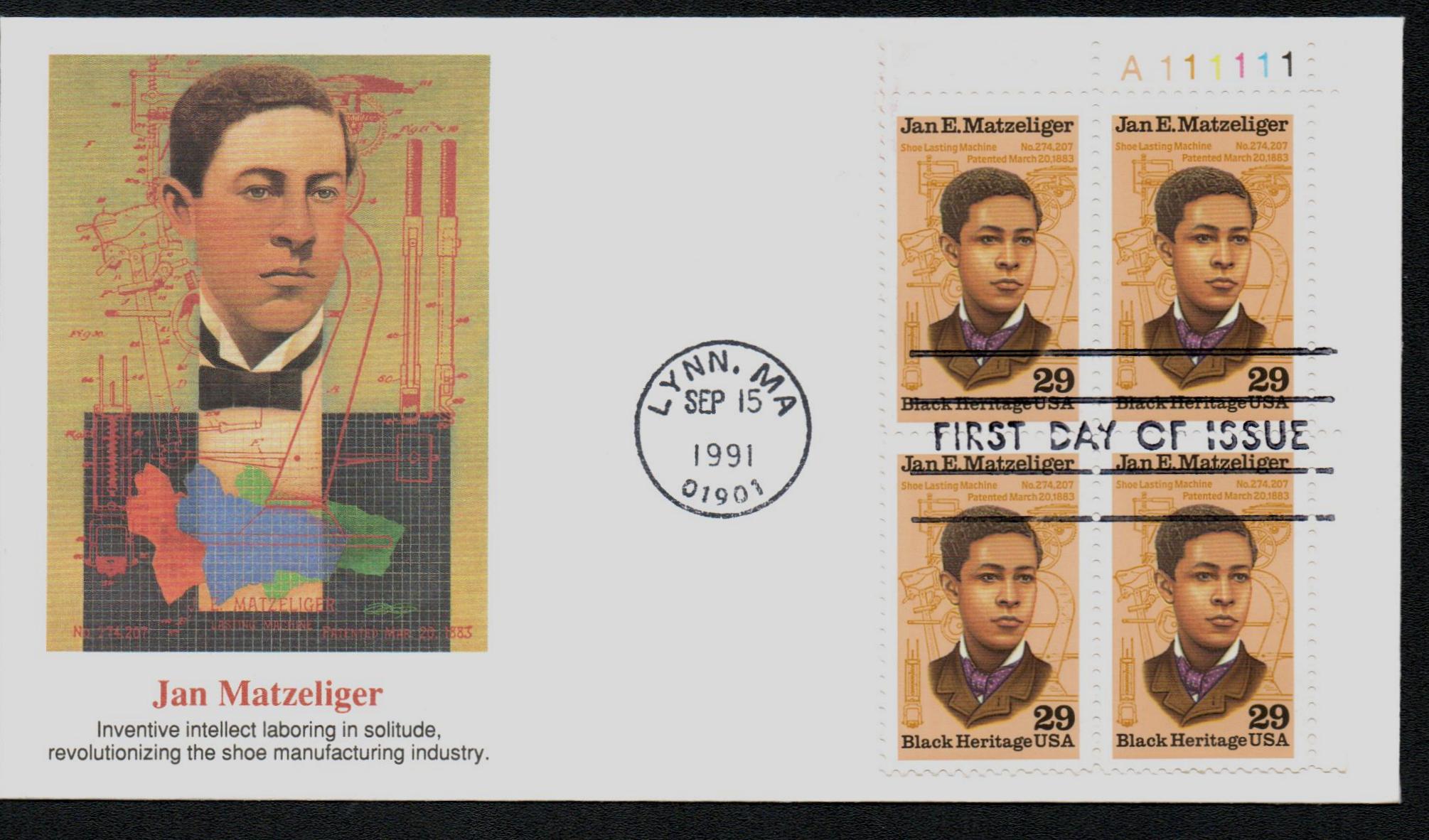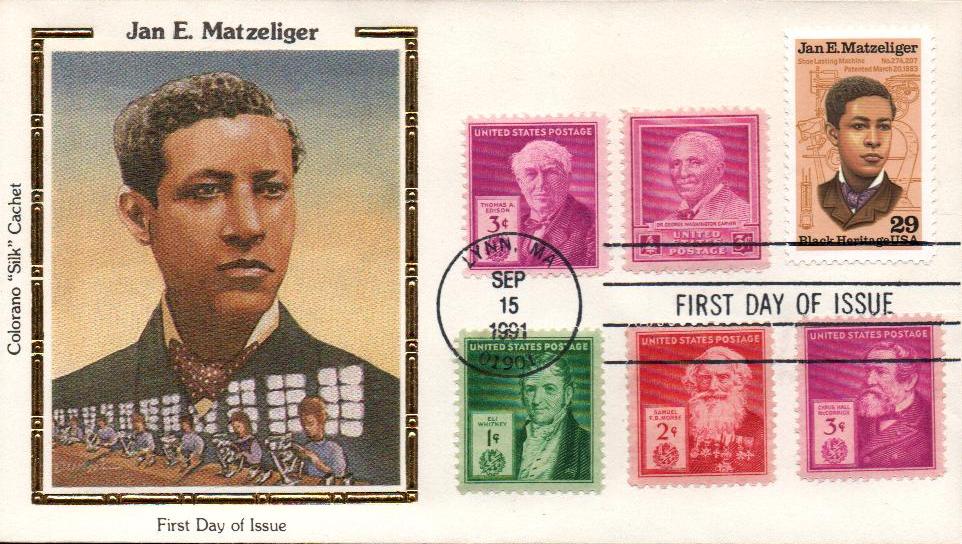
# 2567 FDC - 1991 29c Black Heritage: Jan E. Matzeliger
US #2567
1991 Jan Matzeliger
- First Day Cover
- 14th stamp in Black Heritage Series
- Honors inventor who revolutionized the shoe industry
Category of Stamp: Commemorative
Set: Black Heritage
Value: 29¢
First Day of Issue: September 15, 1991
First Day City: Lynn, Massachusetts
Printed by: J.W. Fergusson and Sons for American Bank Note Company
Printing Method: Photogravure
Format: Panes of 50
Perforations: 11
Reason the stamp was issued: The fourteenth stamp in the Black Heritage Series pays tribute to Jan Matzeliger, an immigrant from Dutch Guiana (Surinam), who revolutionized the shoe industry with various labor-saving machines.
About the stamp design: This stamp is the first for artist Barbara Higgins Bond. There is only one known photograph of Matzeliger, so this was the basis of Bond’s acrylic painting used for the stamp image. The background shows the patent drawing for Matzeliger’s lasting machine.
First Day City: The stamp was issued on his birthday at the Heritage State Park in Lynn, Massachusetts, where Matzeliger spent most of his adult life.
About the Black Heritage Series: The Black Heritage Series began on February 1, 1978, with the issue of the 13¢ Harriet Tubman stamp (US #1744). Since then, the USPS has issued a new stamp in the series every year. A number of them have even been released in February in recognition of Black History month. As of 2023, it was the USPS’s longest-running stamp series of all time.
History this stamp represents:

Inventor Jan Matzeliger was born on September 15, 1852, in Paramaribo, Dutch Guyana (present-day Surinam).
As a boy, Matzeliger worked in his father’s machine shop, the Colonial Ship Works. Early on, he showed a natural talent for working with machinery and mechanics. When he was 19, Matzeliger took a job on a Dutch East Indies merchant ship working as a mechanic. He did that for a few years before moving to Philadelphia, Pennsylvania.
It was in Philadelphia that he became acquainted with the shoe trade. In 1877, he moved to Lynn, Massachusetts to further explore the shoe industry. There he found work in the Harney Brothers Shoe Factory.
In those days, shoes were usually made by hand. The most challenging and time-consuming part of the process was attaching the soles to the top part of the shoe. Many believed this work was so intricate; it could only be performed by human hands. So the people that did this job, called lasters, held significant influence in the shoe industry.

Matzeliger witnessed this issue first hand. He spent five years inventing an automated shoe-laster that shaped and fastened the leather over the sole of the shoe. Up until that point, it took craftsmen 10 hours to attach soles to 50 pairs of shoes. Matzeliger’s machine could make up to 700 pairs of shoes in the same amount of time. Patented in 1883, his device led to the mass production of shoes, revolutionizing the industry and greatly reducing the cost of shoes for consumers.

Matzeliger continued to work on improving shoe production, receiving a few more patents in the years to come. Unfortunately, while he worked tirelessly on his inventions, he worked long hours and didn’t eat for long periods of time, leading his health to suffer. He caught a cold that developed into tuberculosis and died on August 27, 1889, just weeks before his 37th birthday.
US #2567
1991 Jan Matzeliger
- First Day Cover
- 14th stamp in Black Heritage Series
- Honors inventor who revolutionized the shoe industry
Category of Stamp: Commemorative
Set: Black Heritage
Value: 29¢
First Day of Issue: September 15, 1991
First Day City: Lynn, Massachusetts
Printed by: J.W. Fergusson and Sons for American Bank Note Company
Printing Method: Photogravure
Format: Panes of 50
Perforations: 11
Reason the stamp was issued: The fourteenth stamp in the Black Heritage Series pays tribute to Jan Matzeliger, an immigrant from Dutch Guiana (Surinam), who revolutionized the shoe industry with various labor-saving machines.
About the stamp design: This stamp is the first for artist Barbara Higgins Bond. There is only one known photograph of Matzeliger, so this was the basis of Bond’s acrylic painting used for the stamp image. The background shows the patent drawing for Matzeliger’s lasting machine.
First Day City: The stamp was issued on his birthday at the Heritage State Park in Lynn, Massachusetts, where Matzeliger spent most of his adult life.
About the Black Heritage Series: The Black Heritage Series began on February 1, 1978, with the issue of the 13¢ Harriet Tubman stamp (US #1744). Since then, the USPS has issued a new stamp in the series every year. A number of them have even been released in February in recognition of Black History month. As of 2023, it was the USPS’s longest-running stamp series of all time.
History this stamp represents:

Inventor Jan Matzeliger was born on September 15, 1852, in Paramaribo, Dutch Guyana (present-day Surinam).
As a boy, Matzeliger worked in his father’s machine shop, the Colonial Ship Works. Early on, he showed a natural talent for working with machinery and mechanics. When he was 19, Matzeliger took a job on a Dutch East Indies merchant ship working as a mechanic. He did that for a few years before moving to Philadelphia, Pennsylvania.
It was in Philadelphia that he became acquainted with the shoe trade. In 1877, he moved to Lynn, Massachusetts to further explore the shoe industry. There he found work in the Harney Brothers Shoe Factory.
In those days, shoes were usually made by hand. The most challenging and time-consuming part of the process was attaching the soles to the top part of the shoe. Many believed this work was so intricate; it could only be performed by human hands. So the people that did this job, called lasters, held significant influence in the shoe industry.

Matzeliger witnessed this issue first hand. He spent five years inventing an automated shoe-laster that shaped and fastened the leather over the sole of the shoe. Up until that point, it took craftsmen 10 hours to attach soles to 50 pairs of shoes. Matzeliger’s machine could make up to 700 pairs of shoes in the same amount of time. Patented in 1883, his device led to the mass production of shoes, revolutionizing the industry and greatly reducing the cost of shoes for consumers.

Matzeliger continued to work on improving shoe production, receiving a few more patents in the years to come. Unfortunately, while he worked tirelessly on his inventions, he worked long hours and didn’t eat for long periods of time, leading his health to suffer. He caught a cold that developed into tuberculosis and died on August 27, 1889, just weeks before his 37th birthday.








